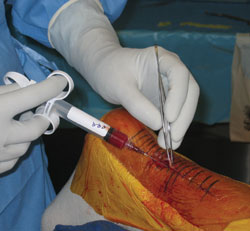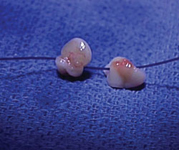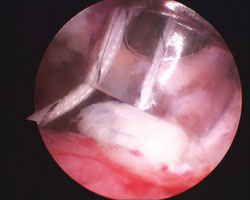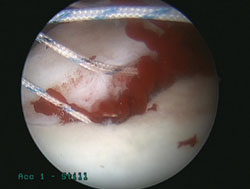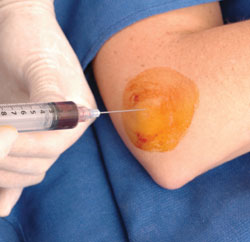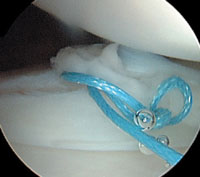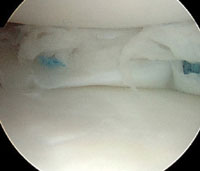The role of platelet-rich plasma in connective tissue repair
Platelet-rich plasma (PRP) is generically defined as an increase (above baseline) in the concentration of platelets and their associated growth factors. While the clinical benefits of PRP in enhancing the healing of musculoskeletal tissues are only beginning to be explored, the substantial amount of basic science data supporting the role of growth factors in enhancing cell migration, cell proliferation, and matrix synthesis has provided a compelling rationale for use of PRP in the treatment and repair of various connective tissue structures.
I have asked a group of leading orthopedic surgeons who have utilized PRP in their respective practices to share their insight and experience regarding the potential role of PRP in enhancing connective tissue repair.
Steven P. Arnoczky, DVM
Moderator
|
|||||||||
Steven P. Arnoczky, DVM: What are your most common indications for using of PRP?
Lesley J. Anderson, MD: I currently use platelet-rich fibrin matrix (PRFM) in rotator cuff repairs. I initially used this in large and massive tears, but have expanded its use for small and medium tears. The ability to facilitate healing at the bone-tendon junction was attractive with the addition of a workable tissue. The ability of growth factors to attract tenocytes and to enhance healing, particularly in the larger tears where the failure rate can be high, was felt to be one of the most positive uses of fibrin matrices.
Gregory C. Fanelli, MD: The PRP product that I use is the Cascade System [Musculoskeletal Transplant Foundation] that produces a PRFM. The PRFM is robust, and can be manipulated and sewn into the tissue where it is being applied. The design of the PRFM allows a slow release of platelet-derived growth factors into the surgical area for approximately 5 to 7 days.
My most common indication for the use of PRFM is knee ligament reconstruction. I routinely use PRFM for ACL and PCL reconstructions and multiple ligament knee reconstructions. I have also used PRFM for patellar tendonosis surgery, and extensor mechanism repair and reconstructions.
Sherwin S. W. Ho, MD: I use PRP for most of the soft tissue repairs that I encounter in my practice: rotator cuff, labral and meniscal repairs; and ACL reconstructions.
|
Image: Mishra A |
Allan Mishra, MD: Connective tissue engineering is a rapidly evolving field in medicine and orthopedic surgery. The ideal biologic tool would be safe, simple to use, inexpensive, and available immediately at the point of care. Importantly, it would also have to be effective. Platelet-rich plasma, meets many of these criteria.
Chronic tendinopathy is the most common indication for applying PRP in my practice. I have used the treatment for tennis elbow, patellar tendinosis, partial Achilles tendon tears and occasionally partial rotator cuff tears as a stand-alone treatment.
I also now routinely augment all of my Achilles and patellar tendon repairs with PRP (Figure 1). Based on the work of Pietro Randelli, MD, and Scott Rodeo, MD, I am considering augmenting my arthroscopic rotator cuff repairs as well with PRP.
For nonunions or difficult fractures, I combine PRP with bone grafting. I have also treated Jones fractures with screw fixation and PRP at the same time.
Nicholas A. Sgaglione, MD: My experience over the last several years has been with the use of PRP in the treatment of younger patients with an isolated meniscus tear — not associated with an ACL tear or reconstruction. Moreover, I use it for those isolated tears that may be considered “biologically at-risk,” associated with tear-site extension into the red-white and even white-white zones, as well as displaced bucket-handle tears and full-thickness radial tears. These meniscal tears can be difficult to treat, but in select patients meniscal preservation may be achieved with biological augmentation of the healing process.
|
|
Images: Anderson LJ |
Arnoczky: How much PRP do you utilize and how do you apply it?
Anderson: In rotator cuff repair, we use a commercially available kit [Cascade] that produces two matrices that are malleable and can be sutured, then inserted arthroscopically (Figure 2). I have recently added an additional 12-minute spin and the clots are much more robust and firm. The two-tube kit is easy for the nurses to use and requires only 18 cc of blood. No special perfusion teams are needed. The clots are threaded on a suture like a string of pearls (Figure 3) and are pulled through the repair site just before tying down the repair sutures (Figure 4). It is best to use a smooth cannula through the diaphragm when passing the matrix so it does not get caught at the opening of the diaphragm. In mini-open repairs, it is inserted directly into the footprint area under the tendon.
|
Image: Anderson LJ |
Fanelli: I will use one or two platelet fibrin matrix plugs for each surgical area that the PRFM is incorporated into. Platelet-rich fibrin matrix is incorporated into the graft preparation for ACL and PCL reconstruction during the tubing and suturing process. Platelet-rich fibrin matrix is incorporated into posterolateral and posteromedial reconstructions by being sewn into the deep layer followed by layered closure over the PRFM material. Because the PRFM is incorporated into the surgical reconstruction, the growth factors are delivered to the deepest layers of the surgical wound in a time-released fashion.
Ho: I use the Biomet GPS (Gravitational Platelet Separation) System, which produces about 5 to 6 cc of PRP from 55 cc of autologous blood. The PRP is mixed with the provided clotting factor and they are simultaneously injected through a mixing tip. Arthroscopically, I inject it through a 6 inch-long 17-gauge spinal needle provided with the syringe kit. I turn off the inflow to allow the PRP to clot in the repair site.
For rotator cuff repairs, I will inject it into the repair site between the cuff and greater tuberosity footprint, after tying down my medial row sutures. Once the clot forms I tie the lateral sutures to trap the PRP clot between the two rows.
Similarly, for labral and meniscal repairs I place my anchors and sutures then inject the PRP and let it clot, which only takes a few seconds. I then tie the sutures down reducing the tear, thus “trapping” the PRP clot in the repair site (Figure 5).
For ACL reconstructions, in. which I use hamstring autografts or anterior (or posterior) tibialis tendon allografts, I pass the long spinal needle alongside the graft after it is in place, laying the PRP clot within the tunnels, alongside the graft, and between the grafts strands intra-articularly. I use 2 cc in the femoral tunnel, 2 cc for the intra-articular portion, and 2 cc in the tibial tunnel.
|
Image: Ho SSW |
Mishra: It is important to clarify that PRP comes in a variety of forms and not all PRP is the same. I prepare PRP using the GPS machine. This system is a simple and reproducible means of obtaining at least five times the baseline level of platelets. The machine also concentrates white blood cells. Both the platelets and white blood cells contain powerful cytokines that can positively influence connective tissue repair. I believe it is the combination of these cytokines that initiates and controls a healing response. I also buffer the PRP to physiologic pH prior to using it.
For a typical tennis elbow patient, I use about 3 ml of PRP. I apply it in an inactivated form (no addition of thrombin or calcium) via a small gauge syringe under a local field block in most cases. The collagen within the tendon acts as an activator of the platelets. I use a peppering technique in which I poke the tendon multiple times and place some PRP below it at the level of the lateral epicondyle and then attempt to place the rest of the PRP within and around the tendon (Figure 6). After 48 to 72 hours, I have the patient begin a rehabilitation protocol.
Sgaglione: Usually 9 cc of autologous blood is drawn from the patient by the anesthesia team from an unheparinized intravenous site at the start of the arthroscopy case when operative indications are confirmed. Centrifugation is initiated with a 6-minute cycle followed by a 15-minute preparation cycle which is accomplished while the meniscal repair site is rasped and prepared and I begin suture repair. I use an arthroscopic approach to insert the volume stable PRP matrix directly into the meniscal tear site following the placement of one or two initial repair sutures.
|
Image: Mishra A |
The delivery of the PRP is facilitated by the use of arthroscopic grasping instrumentation and a metallic portal insertion skid or cannula. The technique can be applied to inside-out, outside-in and all-arthroscopic suturing methods. Following the placement of the PRP matrix into the tear site, it is then incorporated into the repair construct and sutured directly into both of the tear fragments.
Arnoczky: What outcome variables have you looked at to conclude that PRP is beneficial to your patients?
Anderson: Early on, it was noted that patients reported a reduced need for narcotics, a reduced perception of pain and seemed to sleep through the night sooner. I retrospectively reviewed the use of pain medications in the PRFM patients between 2005 and 2007 who underwent rotator cuff repairs and matched them to a consecutive control group during the same period. We found a statistically significant difference between the two groups in that the PRFM group used narcotics for almost half the number of days as the controls.
We are also in the process of modeling the economic benefit of using PRFM in patients receiving workers’ compensation benefits in terms of reducing costs by improving return to work.
With many of our hospitals focused on cost containment, it is somewhat difficult to get new technologies instituted. In that vein, looking at our workers’ compensation patients to compare time to return to work and the cost savings of returning an injured worker back to work after surgery has provided us an economic rationale for its use which may then facilitate its acceptance by our cost-conscious hospitals or surgi-centers.
Fanelli: The outcome variables I have looked at to conclude that PRFM is of benefit to my patients are tunnel expansion and osteolysis on digital radiography, and wound-healing behavior in collateral ligament reconstructions in the multiple-ligament injured knee.
My observations of 70 ACL reconstructions included 34 isolated ACL reconstructions, 30 ACL medial-side reconstructions, and six ACL lateral-side reconstructions. These were primary and revision surgeries. Assessing tunnel expansion and osteolysis with digital radiography, the knees without Cascade PRFM had a 52% incidence of tunnel expansion and osteolysis, while the knees with Cascade PRFM had only a 6.7% incidence of tunnel expansion and osteolysis. I performed all the knee ligament reconstructions using fresh-frozen allograft tissue from the same tissue bank, and all knee reconstructions used the same method and material for graft fixation.
|
|
Images: Sgaglione NA |
Collateral ligament wound healing revealed normal skin tension at 5 days postsurgery, little or no inflammation and no wound breakdown or blisters in knees with Cascade PRFM. No infections occurred in the knees using PRFM. Static stability evaluated with KT-1000 measurements seemed to be improved in combined ACL medial-side reconstructions perhaps due to improved collateral ligament wound healing.
Ho: Although we only began using PRP in 2008, we use clinical exam and MRI scans at 6 and 12 months to evaluate healing time and rates for rotator cuff repairs. We anticipate MRI and clinical evidence of earlier healing with PRP, as well as increased healing rates when compared with nonPRP-treated repairs. For ACL reconstructions, we anticipate a decrease in tunnel widening as well.
Mishra: Peer-reviewed data using the formulation outlined in my technique has been published and confirmed independently to improve pain scores and function of patients with tendinopathy. In my original paper, at 8 weeks after treatment, the PRP patients reported a 60% reduction in Visual Analog Pain scores vs. a 16% reduction in the control group (P = .001). At an average of more than 2-years follow-up, the PRP-treated patients noted a 93% reduction in pain compared to prior to the treatment.
The same protocol using the GPS machine and procedure technique has now been replicated in a 100-person double-blind, randomized protocol in Europe by Taco Gosens, MD, from the Netherlands. His group found PRP to be superior to cortisone in terms of pain relief and functional recovery at 6 months. Their work is presently under review for publication.
For other indications, validated clinical scoring systems are being used by body part. In the future, however, I believe we need to report not just subjective, but also objective outcome variables. Presently, we are investigating the use of ultrasound prospectively as such a tool. Improvement in the hypoechogenic areas of a tendinosis lesion may prove to be a reasonable choice.
Sgaglione: In a series of 40 patients with isolated meniscal repairs, at an average age of 22 years, with precisely defined inclusion and exclusion criteria and average follow-up of 3 years (minimum 2 years), optimal and successful healing has been noted on clinical outcome assessment using subjective, objective and functional assessment and scoring. This can be a difficult problem to treat and the results at this early preliminary follow-up are encouraging with greater than 80% success realized on Lysholm Score and Tegner activity level grading.
Arnoczky: What future role do you foresee PRP having in the orthopedic surgeon’s treatment armamentarium?
Anderson: I believe we have quite a bit to learn from the oral and maxillofacial surgeons who have used this for many years. Since the use in bone healing has not been as well established, the focus seems to be primarily on the use in tendon and soft tissue healing.
The ultimate ability to develop membranes or large matrices of PRPM will allow its use to be expanded. It will be important that the PRP be able to release the growth factors over days to weeks as the process of healing occurs.
Also, using the injectable concentrates in degenerated tendons may allow some healing, or rebuilding of the collagen, but this would obviously require carefully controlled studies.
Fanelli: I believe the use of PRFM is, and will continue to be, useful to the orthopedic surgeon in knee ligament reconstruction procedures.
Observations in my clinical practice have demonstrated decreased tunnel expansion in ACL reconstructions. Platelet-rich fibrin matrix may accelerate ligament healing in tunnels, and may make revision surgery less difficult. There seems to be improved static stability in combined ACL medial side reconstructions, and collateral ligament incisions appear to heal faster.
There appears to be no increased risk of infection with the use of Cascade PRFM. It will be very important to have long-term follow-up, and to have multiple centers making observations to enhance our knowledge base.
Ho: If we are able to prove that PRP increases both healing rates (particularly in those repairs with poor healing rates such as large cuff tears, or avascular or nonvertical meniscal tears) and time to heal, PRP, because of its ease of use and availability, will play a common role in all difficult or slow healing repairs.
Mishra: Platelet-rich plasma’s role as a biologic treatment within orthopedic surgery will rise sharply in the years ahead for several reasons. First, it is autologous. Second, it can be prepared and delivered at the point of care. This makes its safety profile excellent. Finally, it is much more cost effective than genetically engineered single growth factors or stem cells. All of which make it an attractive treatment to study.
We must, however, clarify how to define PRP. It is not appropriate to claim similar results using different formulations and techniques. Standardization of protocols and methods will lead to a better understanding of how to best use PRP.
At Stanford Medical Center, we are actively pursing both basic science and clinical trials with PRP. We are performing cell culture and animal studies to help understand the genetic and molecular mechanisms of this powerful tool. Clinically, we are evaluating PRP as a way to augment micro-fracture surgery, treat partial rotator cuff tears and even potentially treat degenerative disc disease.
Sgaglione: The potential is great and the indications are numerous for many orthopedists and clinicians caring for active patients. However, more compelling controlled comparison data is needed and must be available for true validation of this exciting biological augmentation technology. Specifically, we must be able to show statistically significant differences with healing times, extent of healing, quality of repair tissue, rehabilitation impact and ultimately earlier return to activities with durable outcomes.
For more information:References:
- Lesley J. Anderson, MD, can be reached at 2100 Webster St, Suite 309, San Francisco, CA 94115; 415-923-3029; e-mail: lesley@lakneedoc.com. She received a grant from the Musculoskeletal Transplant Foundation to assist in the review of the data in the retrospective study that was mentioned in this article and has consulted on new technology.
- Steven P. Arnoczky, DVM, can be reached at Michigan State University, G-387 Veterinary Medical Center, East Lansing, MI 48824; 517-353-8929; e-mail: arnoczky@cvm.msu.edu.
- Gregory C. Fanelli, MD, can be reached at 115 Woodbine Lane, Danville, PA 17822-5212; 570-271-6700; e-mail: gfanelli@geisinger.edu.
- Sherwin S. W. Ho, MD, can be reached at University of Chicago Medical Center, 5841 S. Maryland Ave., MC 3079, Chicago, IL 60637; 773-702-5978; e-mail: sho@surgery.bsd.uchicago.edu.
- Allan Mishra, MD, can be reached at Stanford University Medical Center/Menlo Medical Clinic,1300 Crane St., Menlo Park, CA 94025; 650-498-6645; e-mail: am@totaltendon.com. He receives royalties from Biomet Biologics.
- Nicholas A. Sgaglione, MD, can be reached at 600 Northern Blvd., Great Neck, New York, 11021; 516-627–7047; e-mail: nas@optonline.net. He has consulted with the Musculoskeletal Transplant Foundation in the development of products and surgical techniques discussed in the article.
- Gosen T, Sluimer J. Prospective randomized study on the effect of autologous platelets injection in lateral epicondylitis compared with corticosteroid injection. Poster P25-444. Presented at: 13th Congress of the European Society of Sports Traumatology, Knee Surgery and Arthroscopy (ESSKA). May 21-24, 2008. Porto, Portugal.
- Mishra A, Pavelko T. Treatment of chronic elbow tendinosis with buffered platelet-rich plasma. Am J Sports Med. 2006;34(11):1774-1778.
- Mishra A, Woodall J Jr, Vieira A . Treatment of tendon and muscle using platelet-rich plasma. Clin Sports Med. 2009;28(1):113-125.

 Steven P. Arnoczky, DVM
Steven P. Arnoczky, DVM  Lesley J. Anderson, MD
Lesley J. Anderson, MD Allan Mishra, MD
Allan Mishra, MD Gregory C. Fanelli, MD
Gregory C. Fanelli, MD Nicholas A. Sgaglione, MD
Nicholas A. Sgaglione, MD  Sherwin S. W.
Ho, MD
Sherwin S. W.
Ho, MD